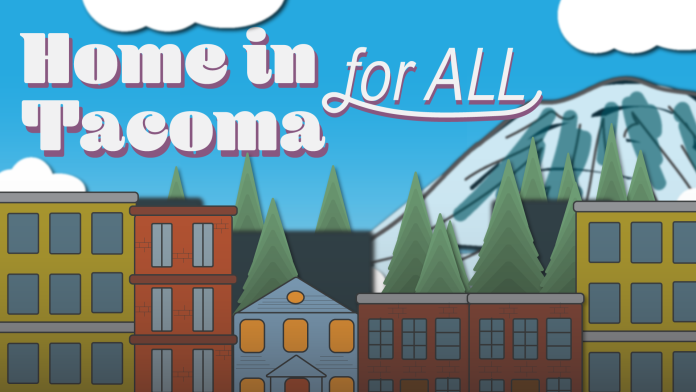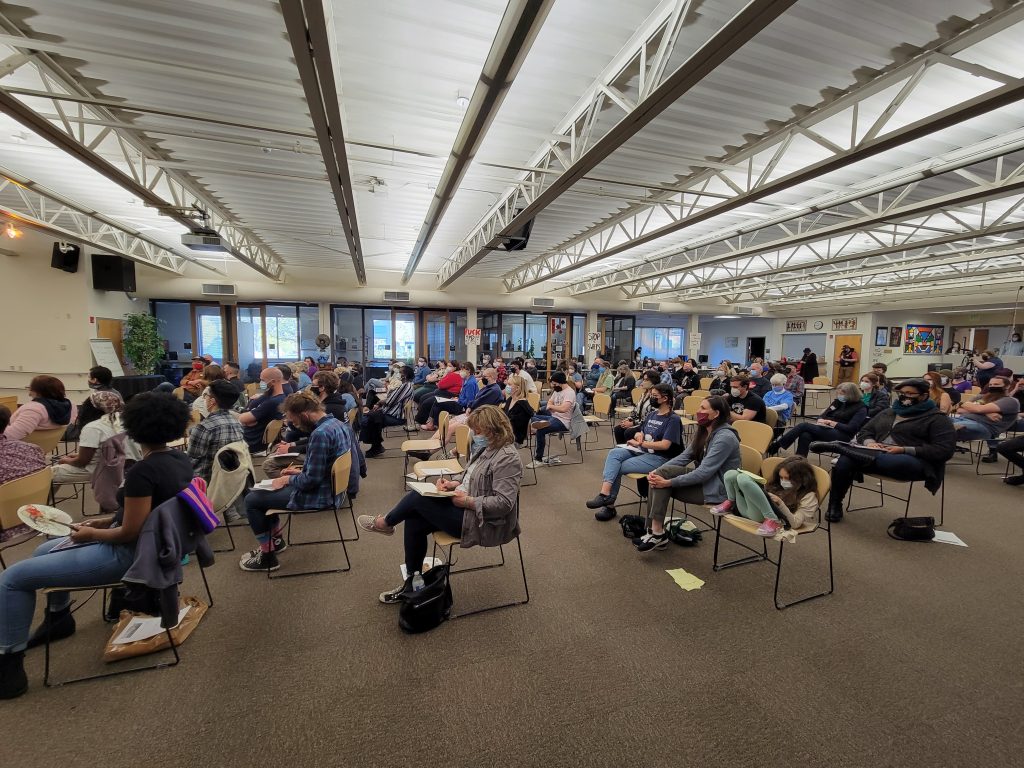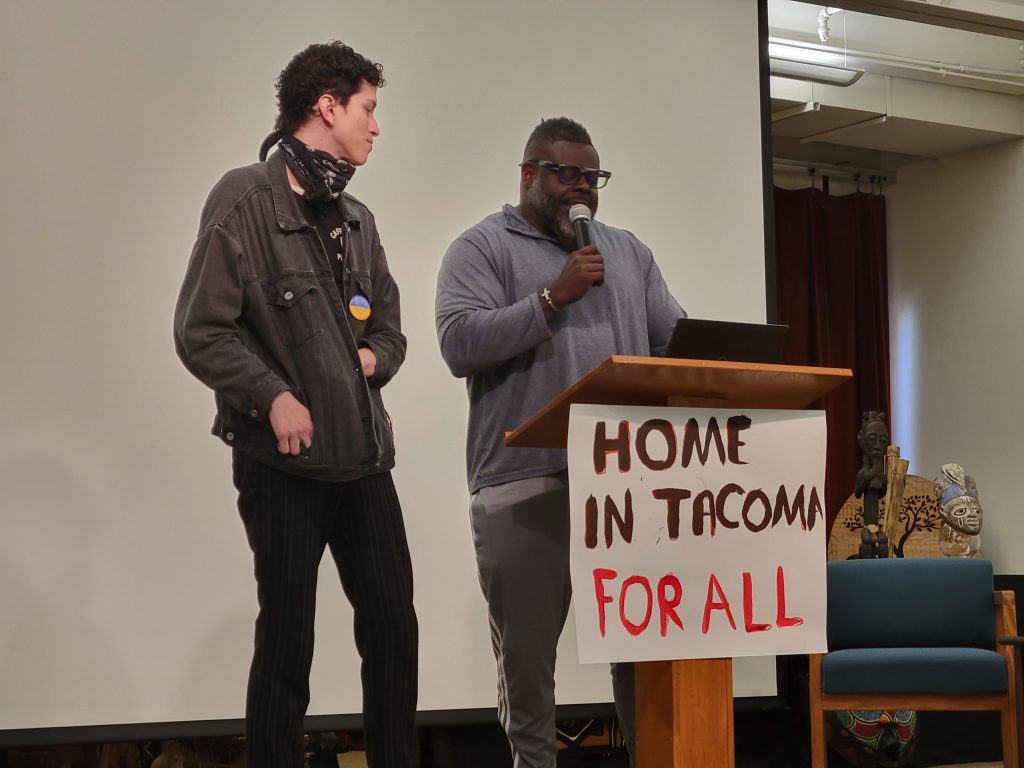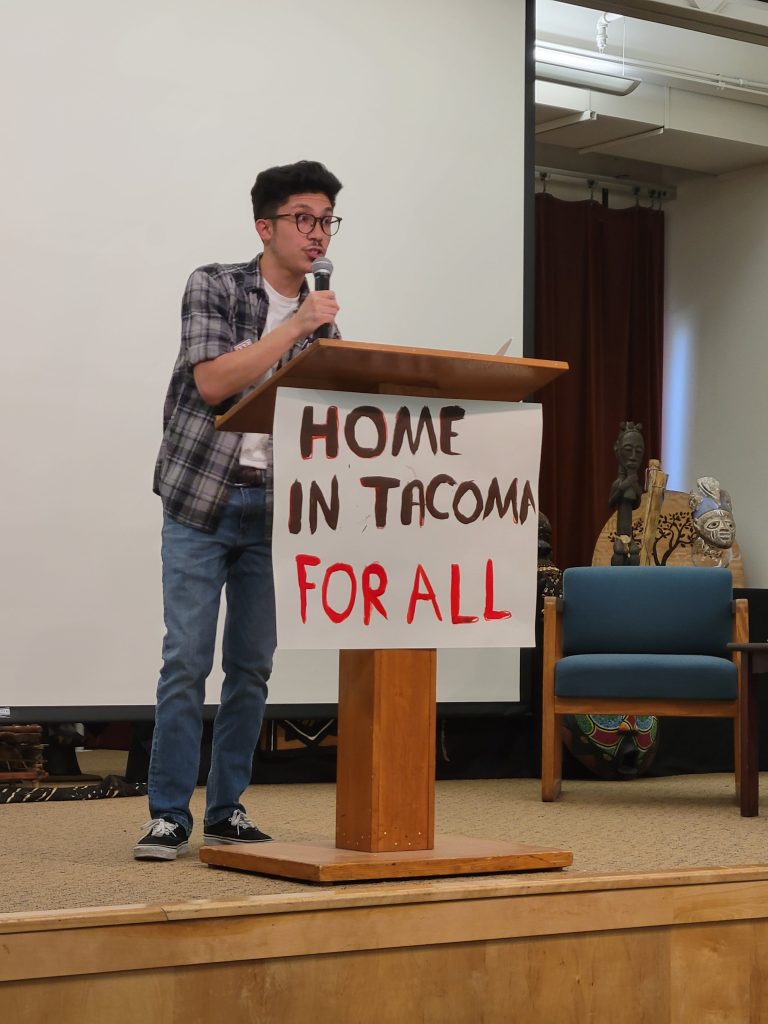Home in Tacoma aims to overhaul Tacoma’s housing rules to allow greater flexibility in building practices. It will allow denser housing to be built to house our city’s ever growing population. The initial framework passed in December 2021 bringing Tacoma are one step closer to that goal. Though forward thinking, the plan also falls short of its potential.
As I’ve pointed out in previous articles, the reach of the plan is not exactly equitable or far reaching. In short, poorer communities of color are being disproportionately rezoned in comparison to their wealthier, whiter counterparts. Communities of color will be transformed while privileged communities get to maintain the status quo. Segregation with some window dressing, if you will.
Others have noticed this pattern, too. The Tacoma-Pierce County chapter of the Democratic Socialists of America (Tacoma DSA) has rallied a coalition of local unions and community groups to call on Tacoma’s City Council to build out Home in Tacoma to serve our communities and individuals more and work to prevent us from falling into the same housing crisis again. This campaign is aptly named Home in Tacoma For All.
On Saturday, Tacoma DSA hosted a community forum to advocate for Home in Tacoma For All in addition to related goals such as protections and services for unhoused folks and low-income renters. Other groups signed on their support and attended were the: Lived Experience Coalition, Tacoma Green New Deal, Serve the People Tacoma, Industrial Workers of the World, House Our Neighbors, United Food and Commercial Workers Union Local 367 (UFCW Local 367) and The Raging Grannies alongside quite a few individual citizens. There were a number of speakers from each group and more that shared experiences and stories alongside specific solutions to ease the burden of housing for all Tacoma renters.
From the perspective of this coalition, Home in Tacoma as it stands generally favors corporate developers, landowners, and wealthy folks. There is text in the plan that states altruistic goals of affordable housing and anti-displacement strategies, but at the same time Tacoma City Council quietly passes adjustments that reduce the scope of Home in Tacoma to limit where this new housing can occur. Additionally, the plan seems to be focused on creating rentals, with little mention of pathways to homeownership or building wealth for working class households.
For all, you say?
In the buzz before the event kicked off, I managed to have a few words in with Michael Whalen, one of the event speakers and vice president and a shop steward for UFCW Local 367. He said that he saw Home in Tacoma for All as a chance to end the pattern of people being priced out of their neighborhoods.
Being priced out is a personal issue for Whalen, as he described that he and his partner were Tacoma residents themselves, until they had to move out of the city due to exorbitant rents. If they had the choice, they likely would have stayed in the city that Whalen is fighting hard for. He told me that he wanted attendees to walk away with the thought that “we’re all human beings, everyone deserves a home.”
Alex Scheel, Secretary-Treasurer of DSA, shared a similar sentiment, stating that “Working class people need to come together collectively and demand real policies that make living in Tacoma and Pierce County available for all.” The diverse group of working-class Tacomans in attendance appeared worried about how bad the housing crisis has gotten and ready to urge holistic action.
Justice-centric housing
The forum was led by Ty Moore, the Campaign Coordinator for Tacoma DSA, who started off by stating the three pillars of the campaign: To create housing for all that is stable, affordable and green. He stated that in the past year, population growth has exceeded housing construction by over double with rent increasing by 22% in the same timespan — an incredibly concerning rate of increase.
First, organizers and community members shared why Home in Tacoma for All was important through their lived experiences. One of the first speakers, Dr. LaMont Green, co-founder of the Lived Experience Coalition, introduced his organization as a grassroots Black, Indigenous, people of color (BIPOC) group with advocates that have experienced homelessness themselves. He said they know what it’s like and can fully support the houseless folks they serve.
One of their advocates, Rosemary, stood next to Dr. Green and shared her experience of realizing her family’s houseless situation as a youth through ever longer stays at motels. She also shared her own struggles of finding housing as a young adult, stating she was only in her current housing through leveraging different housing programs and her network. She took care to mention she was lucky to have no criminal record and a clean financial history, unlike some friends of hers experiencing homelessness.
Oftentimes, a misdemeanor or single past eviction is all the landlord needs to deny a housing application. Through these denials, someone who made a mistake or had an unstable housing situation is unable to escape and find new opportunities.
Rosemary seemed particularly frustrated with the concept of all the initial fees foisted upon renters. Initial deposit, first few months rent, pet deposit, pet rent, cleaning fees, moving fees, storage fees, application fees, the list goes on. How could a young adult on their own even fathom paying all of that? In this economy? When asked who actually made three times their rent, the audience met the question with jeers and laughs.
Dr. Green pointed out that housing justice and racial justice must go hand in hand. He noted that a recent housing report uncovered disparate approval rates for refinancing home mortgages between races in the Covid-19 era. Specifically, the report found that low income, education and credit score White homeowners had a much higher approval rate than comparatively higher income, education and credit score Black homeowners.
“In our movement we must have an explicit racial justice analysis or it’s not gonna work,” Green said.
Whalen took to the microphone to speak on behalf of commercial and food service workers. He presented the dangers of workers in these industries today, whether abuse from employers or physical harm from violent customers in addition to the struggle to afford housing because of the typical low wages. People need safe spaces to work and Whalen said that is directly connected to the conditions that people live under.
“While rents rise and real estate can bring in money and build luxury homes for the community that will be moving in, working people and the helpless are systematically and physically being swept out. We need Home in Tacoma for All, so we can have the safety of not losing our homes and attack the conditions of poverty that foster unsafe stores and communities,” he said.
Tacoma Green New Deal was represented by Marquis Mason, who spoke on seizing this once in a generation opportunity to tackle Tacoma’s environmental issues in a big way. By tying environmentalism into Home in Tacoma, he stated that “we can mandate through zoning what good green growth looks like in the future.”
The type of growth he described would move away from large streets that divide up communities, use of faulty natural gas lines that increase the rates of asthma in children and unsustainable building practices and towards healthier, closer, greener communities.
Seattle University professor Zachary Wood spoke on public housing, referring to his efforts to bring it to Seattle. He shared his perspective that public housing, as in actually owned by the public, does not exist in the United States. Social housing, which he defined as government subsidized, does exist, but it is far apart from being housing that’s truly owned by the public. Government subsidized housing also its own slew of issues in the U.S. as a result of its “messy history based on racism and segregation.”
In Wood’s viewpoint, one of the key issues is that even affordable housing is treated as a commodity. In many types of “solutions” to housing shortages, housing and property are valued and commodified. “Market price” housing is a term usually thrown around, but that term is so ambiguous to the layperson. What is it? What if you’re a low-income person and “market price” is far out of reach?
Pricing for “80% of market price/area median income” is often mentioned when discussing affordable housing, but to Wood that’s more like crumbs when working people deserve the cake. A sign hung at the event hit on this theme by saying “keep Tacoma working class.”
There is money to be made by someone and that takes precedence over another’s life and comfort, Wood argued, adding that the private market will never provide equity or equitable access. At times public land is sold to private developers to get maybe 10 or 15% affordable housing across the whole area, Woods said.
Publicly owned housing is a solution Wood said he thinks can be incorporated into Home in Tacoma For All. Housing needs to be taken out of the private market to make it permanently affordable. To make it permanent, he proposed a creating a public corporation take control of land and act as the landlord. This publicly controlled corporation would be democratically run and be tasked with maintaining affordable housing in perpetuity. This could decrease the harms caused whims of out-of-state developers or faceless banks charging absurd rates or denying applications.
Additionally, this public corporation could provide pathways to homeownership for low-income workers that are not typically provided by corporate or private landlords, which is a potential way out of the cycle of poverty so many people are stuck in.
The fabric of neighborhoods
Local organizer Mattice Hoyt spoke as a Black business owner and homeowner. She first spoke of being priced out of Seattle in 2010, which forced her to move down to Tacoma. There, she discovered a tight knit community that looked out for her. As a disabled person in a motorized wheelchair, her neighbors would often watch out for her, shoveling snowy sidewalks or helping with chores to support her. But over the years, the fabric of her neighborhood changed as prices rose and those familiar faces were slowly pushed out. Nowadays, neighbors are distant from one another, if they even know each other.
That story has taken place throughout Tacoma, whether we notice it or not.
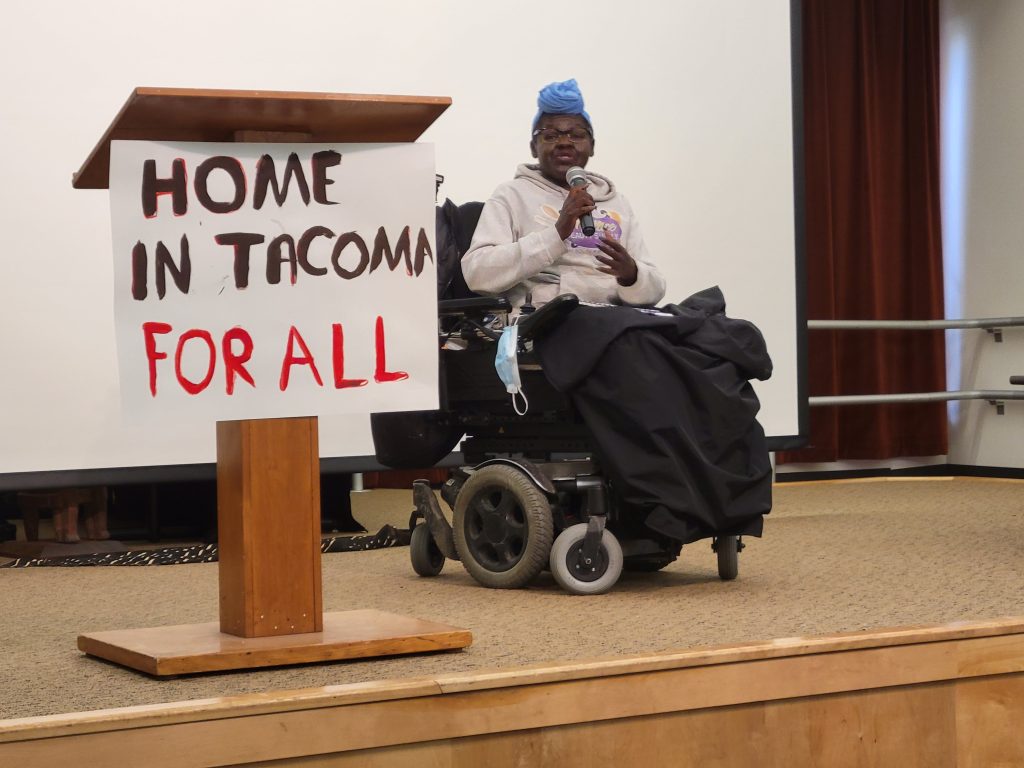
As a business owner, she was disappointed in the divided response from Tacoma small businesses. Many have rallied under the banner of Tacoma Safe, a coalition of Tacoma residents and businesses calling for enhanced policing, encampment sweeps and other short-term measures not aimed at the root causes, such as the housing shortage. She has been one of the few to stand against Tacoma Safe, despite their best efforts to bring her to their side.
Hoyt said that business owners’ responsibility is not to report these houseless individuals and drive them away but to get to know them and learn about who they are.
“Homelessness is not who people are, they are their own people. I say that as a disabled person. I say that as a Black person. I am not just a Black person, I am Mattice. And homelessness is just a situation.”
By recognizing this and engaging with homeless folks, business owners can build community and understanding rather than fostering hostility and division. Of course that is easier said than done, but it can be accomplished in many creative ways. For example, in her beauty supply business, Hoyt has a conference room that any community member can use free of charge. The only condition is that they must be doing good work and trying to make a positive difference in their community. That is the payment and that is how communities grow together. Other businesses can also share space, money, or just simply their time.
So what now?
Enhancing Home in Tacoma could happen in a number of ways. The other speakers at the event spoke about the immense barriers for formerly incarcerated individuals and formerly houseless folks, efforts to create unarmed crisis response teams, ecologically focused landscaping, a Renter’s Bill of Rights, and additional pathways to homeownership.
The core pillars of the campaign was readily apparent through the passion of these speakers and the attendees. These folks were demanding that the City of Tacoma provide affordable housing so that everyone can find a place to lay their head, stable housing so that no one needs to worry about having their lives upturned, and green housing so our communities can be healthy and vibrant.
Looking to the summer, this coalition will continue to host events and get more community members on board with their platform. Work will continue through April 2023, when the City’s community engagement portion of the plan will wrap up and a vote will be cast on the final version of Home in Tacoma.
To learn more about the Home in Tacoma for All campaign, sign their petition and get involved, click here. To watch a full recording of the event and hear from all the speakers, click here.
The City of Tacoma continues to take public comment at homeintacoma@cityoftacoma.org through April 30th.

Kevin Le
Kevin Le is a Geographic Information Science (GIS) professional in Tacoma. He enjoys studying spatial data to better understand our urban landscapes and redesign cities to better serve all people.

